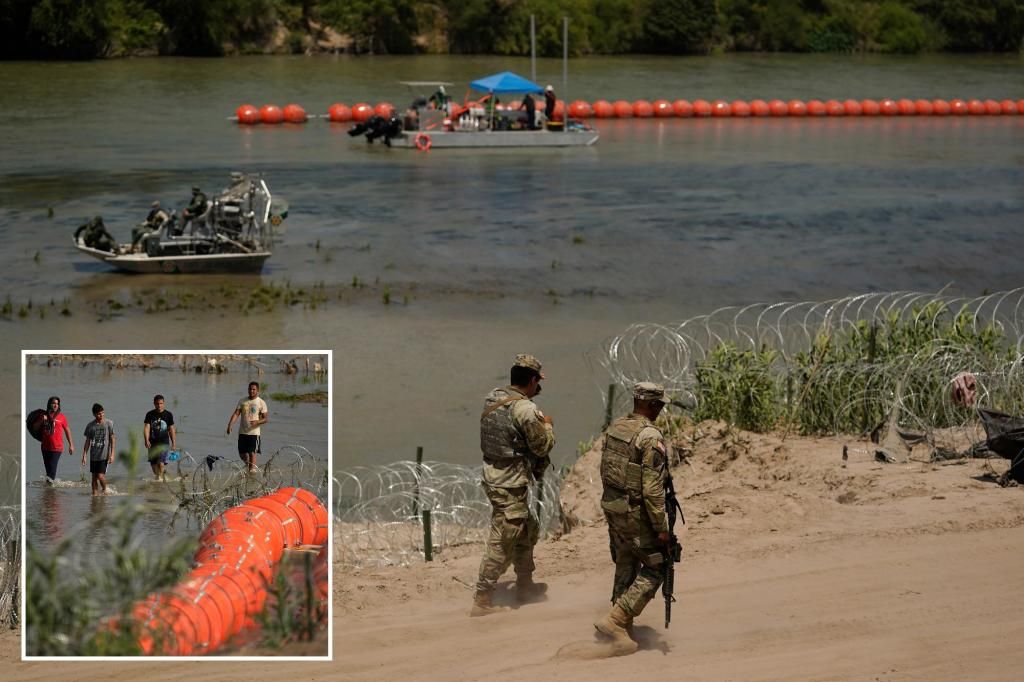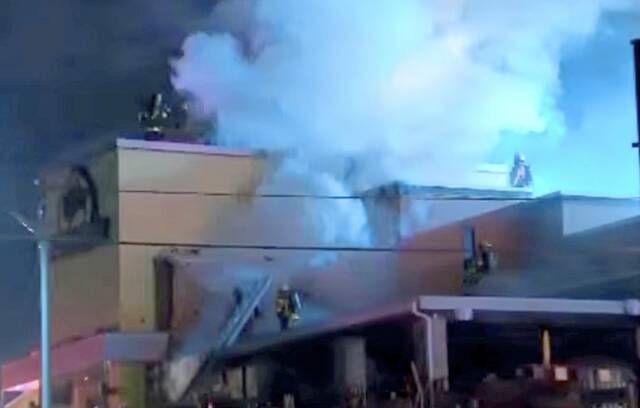Texas floating barrier placed in Rio Grande to stop migrants
Texas’ latest measures to keep illegal immigrants from crossing into the state between official points of entry was rolled out Wednesday with a 1,000-foot floating barrier strung across the river separating the US from Mexico.
Workers have arranged large orange buoys across the middle of the Rio Grande, which doubles as the international boundary, near Eagle Pass, Texas — which is an an illegal crossing hot spot.
“The buoys go down a foot below the water line, so anyone wanting to get past them would have to swim at least that far down,” Texas Department of Public Safety Spokesman Lt. Chris Olivarez told The Post.
So far, migrants trying to make their way into the US have not attempted to go over them or under them, Olivarez said, adding gaps in certain areas are still being closed.
It will take another week or so before they can be anchored to the river bed and the work is completed.
Guardsmen patrol as workers continue to deploy large buoys on Wednesday. AP
Buoys were placed into the Rio Grande throughout the course of this week. AP
“Most [migrants], they don’t want to go under water, they’re trying to scale over, like a wall,” Olivarez explained.
“Especially with children, I think it’s going to be most effective with families who are trying to come across. Across the board, we want to prevent people from crossing the river in the first place.”
Migrants who cross into the US through Texas have no other option than to wade through the waters of the Rio Grande, as it stretches the entire length of the state from El Paso, in the western corner of the state, all the way to the Gulf of Mexico, some 1,885 miles east.
Migrants look on as the buoys are put into place. AP
The barrier is designed to stop illegal migrants from crossing the river between official checkpoints. AP
In some parts of the state, the water is ankle deep, while in other sections, like Eagle Pass, anyone crossing it must contend with fierce river currents notorious for drowning people — even without the further obstace of buoys in the river.
That has caused concerns among immigrants’ rights groups that the buoys could lead to deaths, if migrants attempt to cross the River. Gov. Abbott has said the buoys are in place as a deterrent to stop people from even trying.
The International Boundary and Water Commission, a federal agency which is in charge of the Rio Grande said Texas never submitted a plan for the water floats or obtained permits for them.
“The State of Texas still has not contacted US [International Boundary and Water Commission] about its plans or requested a permit,” confirmed IBWC spokesman Frank Fisher.
“We are still studying the situation and considering our options,” the IBWC added when asked about the buoys deployed in the river.
The effectiveness of the buoys have yet to be fully tested, they go at least 12″ below the water’s surface. AP
The State of Texas has installed the floating barrier over the Rio Grande, the river that separate Mexico from the US and also served as the international boundary. AP
Governor Abbott has remained defiant, saying he will welcome any challenges in court and is prepared to take the case as far as the Supreme Court if necessary, adding in a Tweet: “Texas has a constitutional right to secure our border.”
This dispute over authority to secure the border is the latest point of conflict between the federal government and the Republican state.
Federal immigration agents have also objected to the razor wire Texas uses to block illegal immigrants from entering the US, according to a newly released memo.
A new document from the US Border Patrol warns of the dangers of the razor wire placed at the border by the State of Texas. Anadolu Agency via Getty Images
The razor wire has been added to parts of the Texas border with Mexico as part of Gov. Greg Abbott’s border security plan called Operation Lone Star. Members of the Texas military as well as the Texas state troopers have also been assigned to patrol the border. Getty Images
“Currently there is no path forward if [Texas Department of Public Safety] DPS continues to deploy the concertina wire,” reads a June 26 document obtained by Hearst Newspapers.
At the direction of Gov. Greg Abbott, the Texas DPS has added the wire across much of the US-Mexico border in the Eagle Pass area.
However, once illegal immigrants make it across the river, they are already on US soil, and the Border Patrol has a legal obligation to process them once they reach the river bank, federal sources tell The Post.
Federal agents are not allowed to go into the water and attempt to stop migrants from entering the country, as the threat of drowning for both agents and migrants is too great.
Since mid-May, the Texas governor has order DPS troopers who are also down on the border to stop migrants who are in the river from setting foot on dry land, by blocking passage with razor wire.
Gov. Abbott’s Office did not immediately respond to The Post’s request for comment.
Source: New York Post


